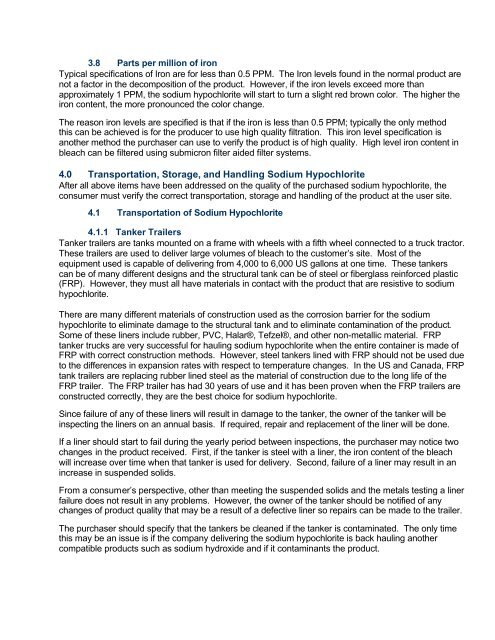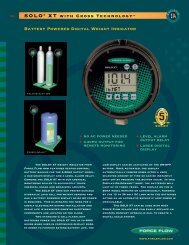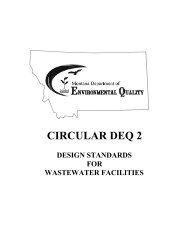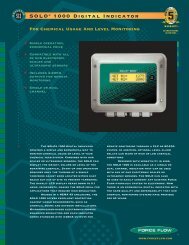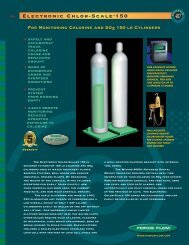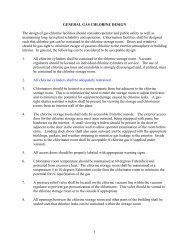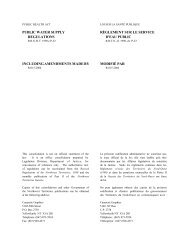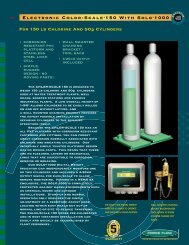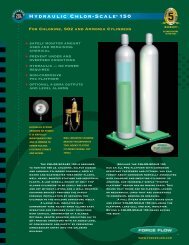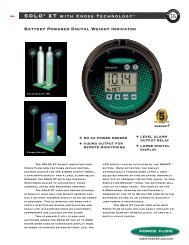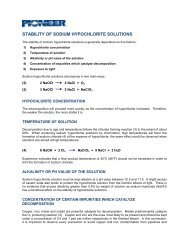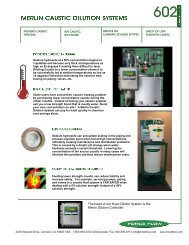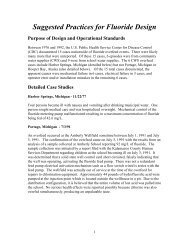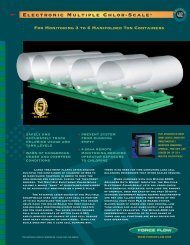Sodium Hypochlorite Handbook - Force Flow
Sodium Hypochlorite Handbook - Force Flow
Sodium Hypochlorite Handbook - Force Flow
You also want an ePaper? Increase the reach of your titles
YUMPU automatically turns print PDFs into web optimized ePapers that Google loves.
3.8 Parts per million of ironTypical specifications of Iron are for less than 0.5 PPM. The Iron levels found in the normal product arenot a factor in the decomposition of the product. However, if the iron levels exceed more thanapproximately 1 PPM, the sodium hypochlorite will start to turn a slight red brown color. The higher theiron content, the more pronounced the color change.The reason iron levels are specified is that if the iron is less than 0.5 PPM; typically the only methodthis can be achieved is for the producer to use high quality filtration. This iron level specification isanother method the purchaser can use to verify the product is of high quality. High level iron content inbleach can be filtered using submicron filter aided filter systems.4.0 Transportation, Storage, and Handling <strong>Sodium</strong> <strong>Hypochlorite</strong>After all above items have been addressed on the quality of the purchased sodium hypochlorite, theconsumer must verify the correct transportation, storage and handling of the product at the user site.4.1 Transportation of <strong>Sodium</strong> <strong>Hypochlorite</strong>4.1.1 Tanker TrailersTanker trailers are tanks mounted on a frame with wheels with a fifth wheel connected to a truck tractor.These trailers are used to deliver large volumes of bleach to the customer’s site. Most of theequipment used is capable of delivering from 4,000 to 6,000 US gallons at one time. These tankerscan be of many different designs and the structural tank can be of steel or fiberglass reinforced plastic(FRP). However, they must all have materials in contact with the product that are resistive to sodiumhypochlorite.There are many different materials of construction used as the corrosion barrier for the sodiumhypochlorite to eliminate damage to the structural tank and to eliminate contamination of the product.Some of these liners include rubber, PVC, Halar®, Tefzel®, and other non-metallic material. FRPtanker trucks are very successful for hauling sodium hypochlorite when the entire container is made ofFRP with correct construction methods. However, steel tankers lined with FRP should not be used dueto the differences in expansion rates with respect to temperature changes. In the US and Canada, FRPtank trailers are replacing rubber lined steel as the material of construction due to the long life of theFRP trailer. The FRP trailer has had 30 years of use and it has been proven when the FRP trailers areconstructed correctly, they are the best choice for sodium hypochlorite.Since failure of any of these liners will result in damage to the tanker, the owner of the tanker will beinspecting the liners on an annual basis. If required, repair and replacement of the liner will be done.If a liner should start to fail during the yearly period between inspections, the purchaser may notice twochanges in the product received. First, if the tanker is steel with a liner, the iron content of the bleachwill increase over time when that tanker is used for delivery. Second, failure of a liner may result in anincrease in suspended solids.From a consumer’s perspective, other than meeting the suspended solids and the metals testing a linerfailure does not result in any problems. However, the owner of the tanker should be notified of anychanges of product quality that may be a result of a defective liner so repairs can be made to the trailer.The purchaser should specify that the tankers be cleaned if the tanker is contaminated. The only timethis may be an issue is if the company delivering the sodium hypochlorite is back hauling anothercompatible products such as sodium hydroxide and if it contaminants the product.


